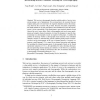Free Online Productivity Tools
i2Speak
i2Symbol
i2OCR
iTex2Img
iWeb2Print
iWeb2Shot
i2Type
iPdf2Split
iPdf2Merge
i2Bopomofo
i2Arabic
i2Style
i2Image
i2PDF
iLatex2Rtf
Sci2ools
TASE
2008
IEEE
2008
IEEE
Reasoning about Channel Passing in Choreography
Abstract Web services choreography describes global models of service interactions among a set of participants. For an interaction to be executed, the participants taken part in it must know the required channel(s) used in the interaction, otherwise the execution will get stuck. Because of dynamic composition, the initial channel set on each participant is often insufficient to meet the requirements. It is the responsibility of the participants to pass required channels owned (known) by one to some others. Since a choreography may involve many participants and complex channel constraints, it is hard for designers to specify channel passing in a choreography exactly as required. In this paper, we address the problem of checking whether a choreography lacks channels or has redundant channels, and how to automatically generate channel passing based on interaction flows of the choreography in the case of channel absence. Concretely, we propose a small language Chorc named for an channel ...
| Added | 01 Jun 2010 |
| Updated | 01 Jun 2010 |
| Type | Conference |
| Year | 2008 |
| Where | TASE |
| Authors | Hongli Yang, Chao Cai, Liyang Peng, Xiangpeng Zhao, Zongyan Qiu |
Comments (0)

